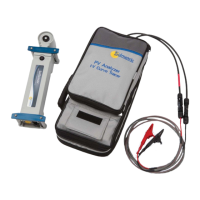4 Making Measurements
4-7
Navigate to the location in the tree that matches where you are making your
measurement. Highlight that branch of the Tree and click the Assign and Save button. If
you don’t want to save the trace but do want the software to compare the measured trace
with the predictions of the PV model, instead press the Assign Only button. The Array
Tree closes and the I-V curve expands to its full width.
Inspect the curve for abnormal shapes. Also notice the values of the Fill Factor and the
Performance Factor below the I-V curve graph. Fill Factor gets smaller if the I-V curve is
badly shaped. Expect Performance Factors to be mostly in the 90-100% range for a new,
clean array; if the values are way higher or lower than that, check that the irradiance
sensor is mounted in the plane of the array, that the computer’s date, time, and time zone
are correct, and that the 17 PV module parameters are correct , and that your array
azimuth and array type are correctly set.
TIP: Does your I-V curve end way short of the horizontal axis? Or does the I-V curve
appear to be made up of several long straight lines? If so, just press Measure Now again
and save onlythe newer I-V curve. This can happen on the first measurement of the
session, or if the string under test has very different electrical behavior from the ones you
measured before it. It is a side effect of a feature in which the PV Analyzer keeps
improving its performance by optimizing its internal configuration based on the previous
measurements.
Inspect the sensor values that were saved with the measurement. They appear directly
below the I-V curve graph.
Select the next PV circuit and take another measurement
Lift the previous fuse and insert the next one.
Repeat the above steps to make and save your measurement.
Be aware that when your measurements are all finished and the data is exported from the
PVA software, the software exports only the last measurement saved to each branch of
the Array Tree. If you take some extra measurements while troubleshooting a string that’s
underperforming, be sure to take one final measurement of the repaired string, for export.
View the consistency of your data before moving on
Before moving to the next combiner box or inverter, click on the History tab and scroll
left-to right to see the numerical results of the measurements at this combiner box. Your
most recent measurement appears in the left column.
For example, the Voc values should be closely grouped, indicating that the strings all
have the right number of modules.
The Isc values should be closely grouped as well, if it’s a clear day and the irradiance is
nearly constant.

